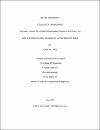Optimal sizing of hybrid renewable energy systems: an application for real demand in Qatar remote area
الملخص
Renewable energy (RE) sources are becoming popular for power generations due to advances in renewable energy technologies and their ability to reduce the problem of global warming. However, their supply varies in availability (as sun and wind) and the required load demand fluctuates. Thus, to overcome the uncertainty issues of RE power sources, they can be combined with storage devices and conventional energy sources in a Hybrid Power Systems (HPS) to satisfy the demand load at any time. Recently, RE systems received high interest to take advantage of their positive benefits such as renewable availability and CO2 emissions reductions. The optimal design of a hybrid renewable energy system is mostly defined by economic criteria, but there are also technical and environmental criteria to be considered to improve decision making. In this study three main renewable sources of the system: photovoltaic arrays (PV), wind turbine generators (WG) and waste boilers (WB) are integrated with diesel generators and batteries to design a hybrid system that supplies the required demand of a remote area in Qatar using heuristic approach. The method utilizes typical year data to calculate hourly output power of PV, WG and WB throughout the year. Then, different combinations of renewable energy sources with battery storage are proposed to match hourly demand during the year. The design which satisfies the desired level of loss of power supply, CO2 emissions and minimum costs is considered as best design.
DOI/handle
http://hdl.handle.net/10576/5796المجموعات
- الإدارة الهندسية [147 items ]


